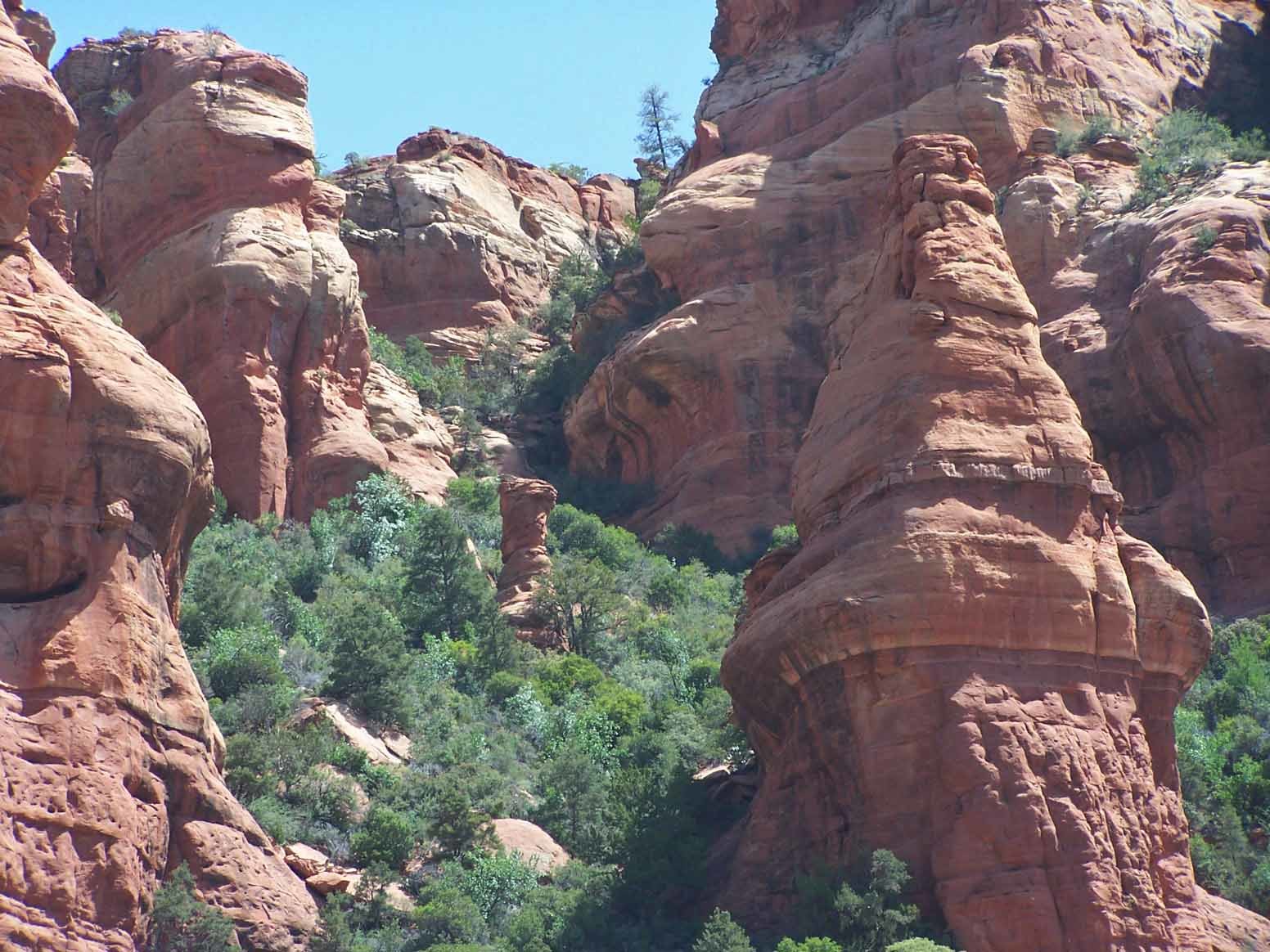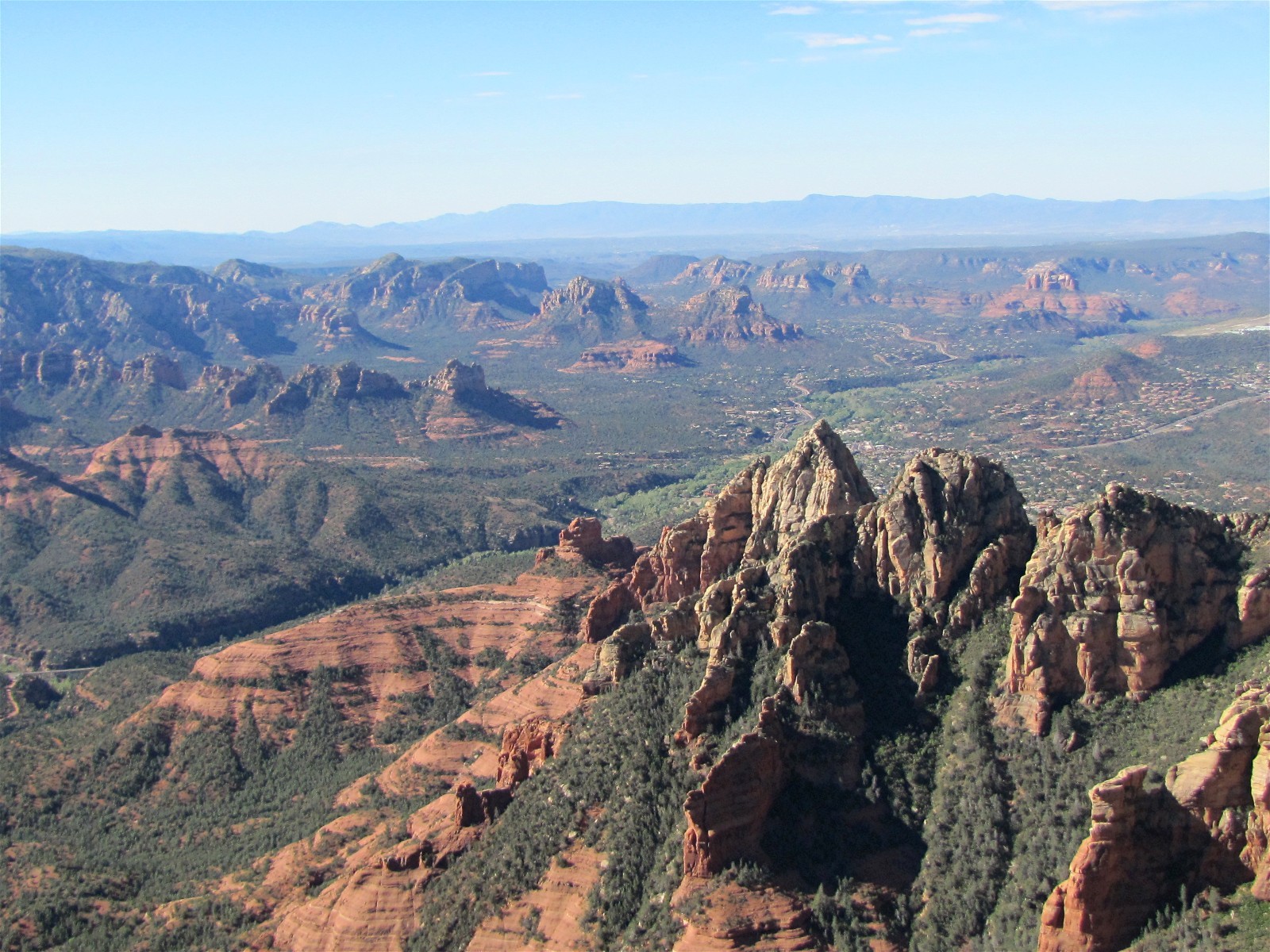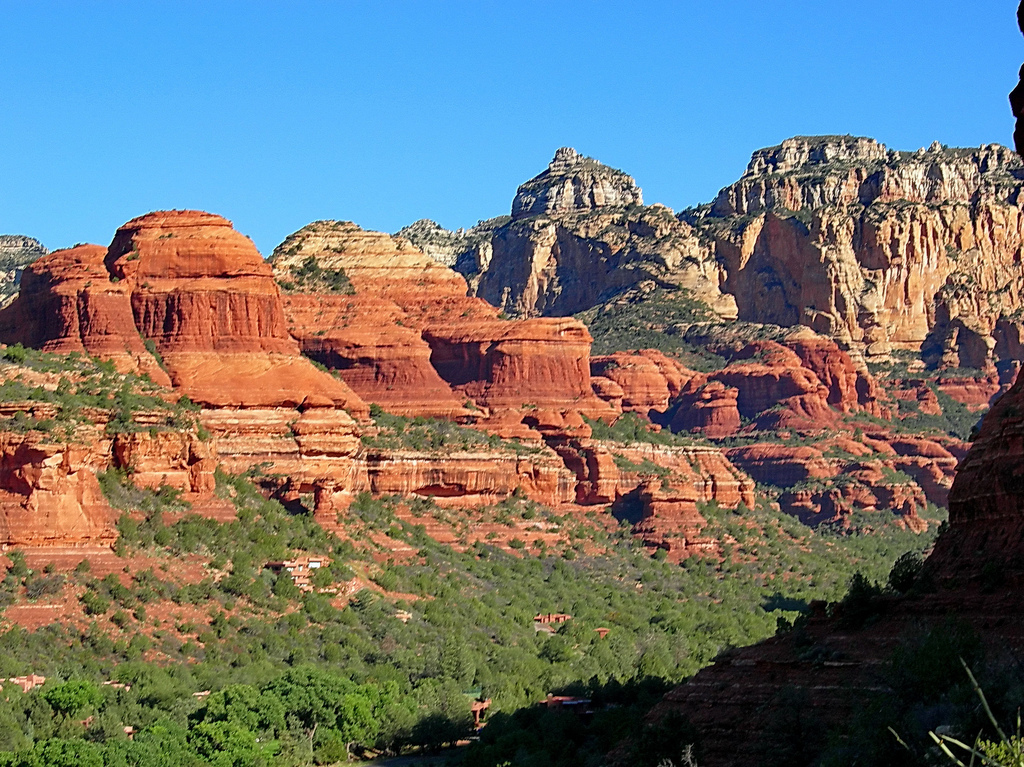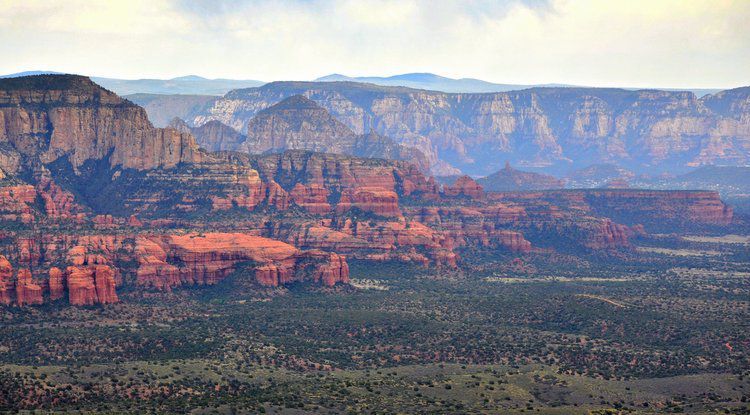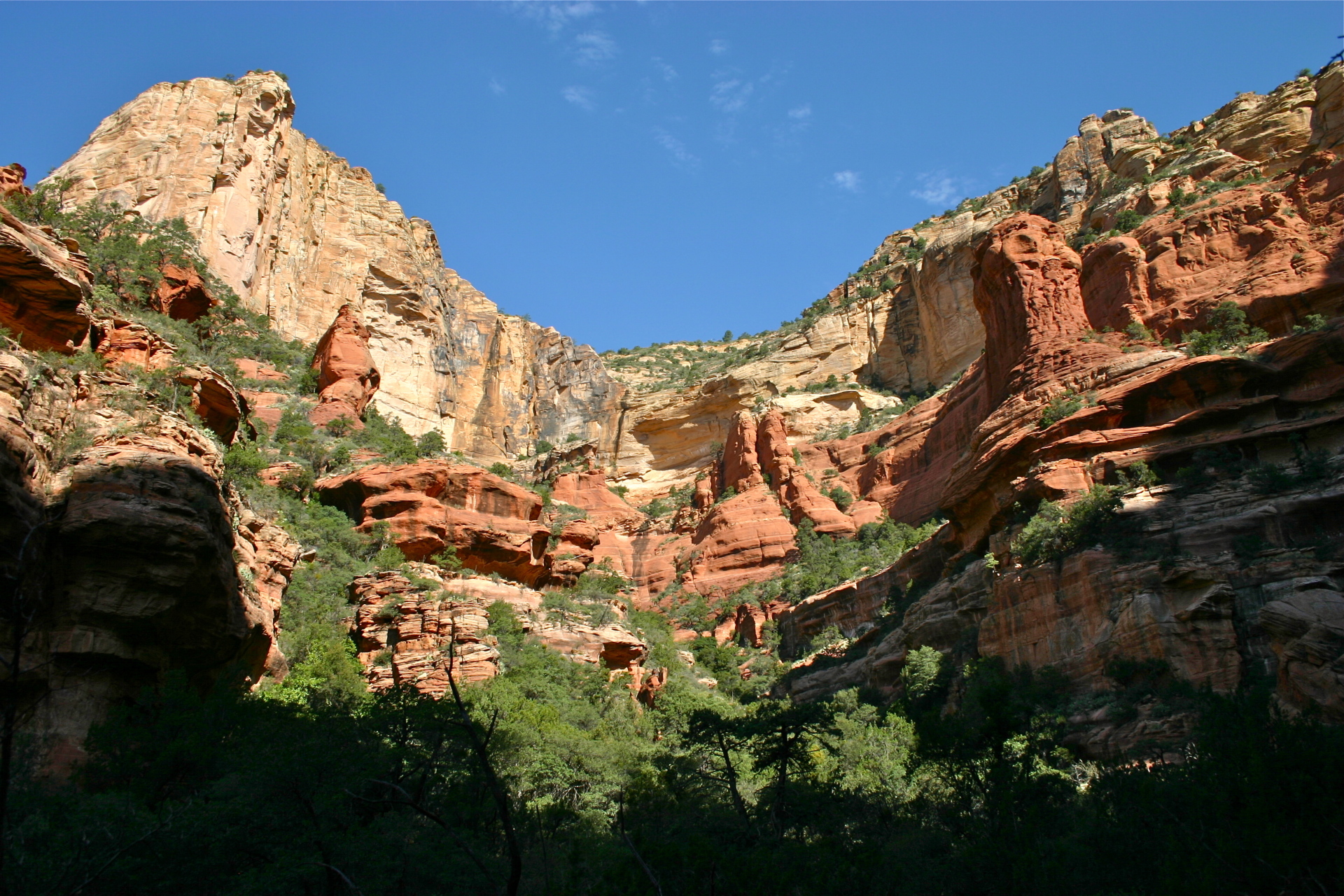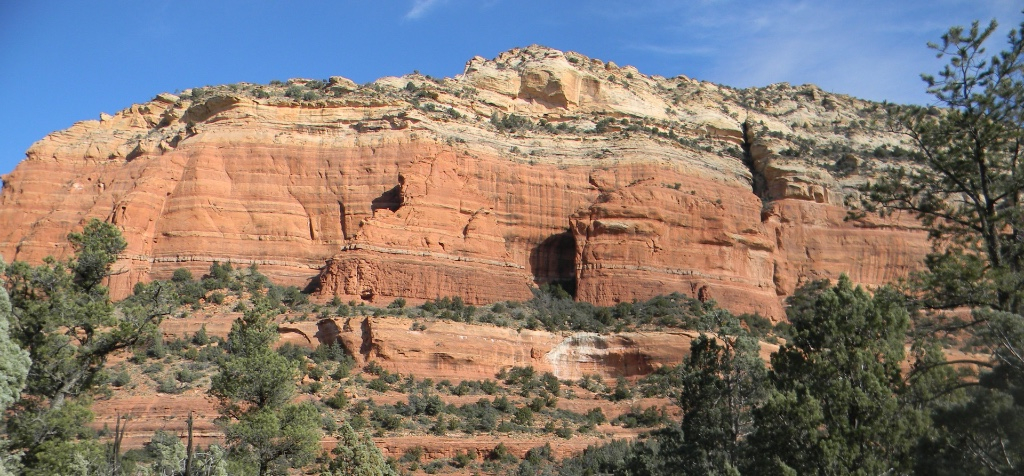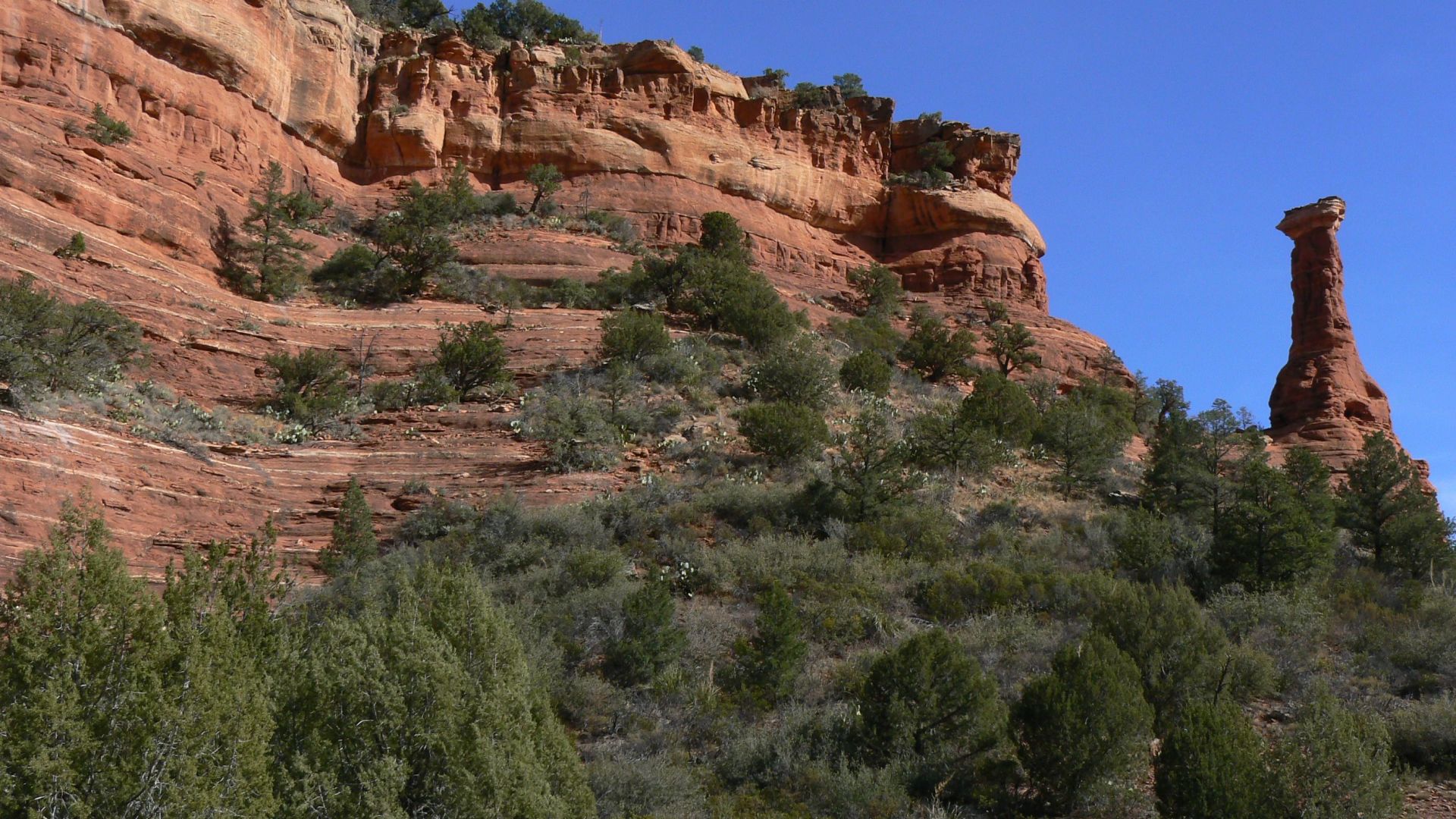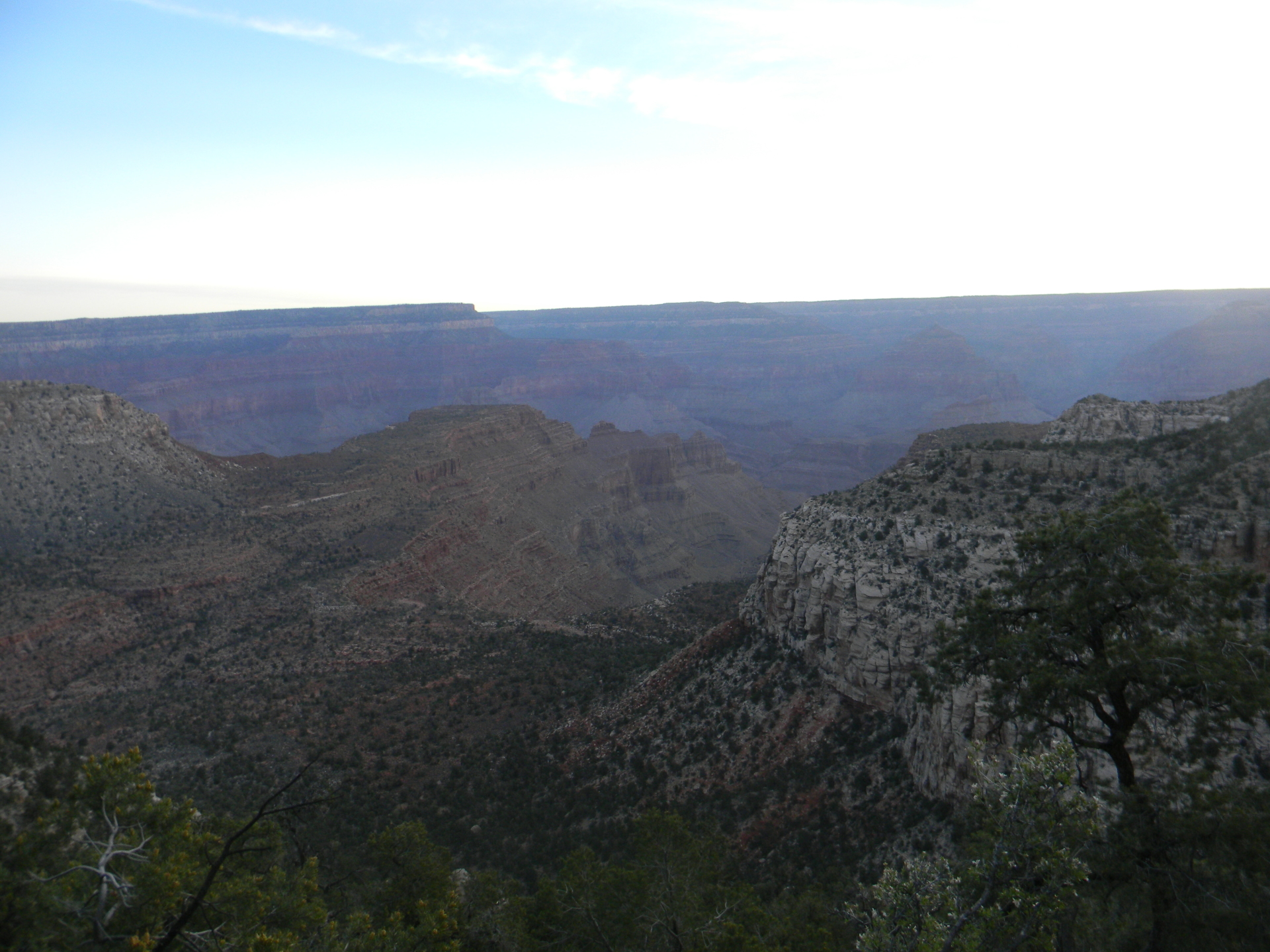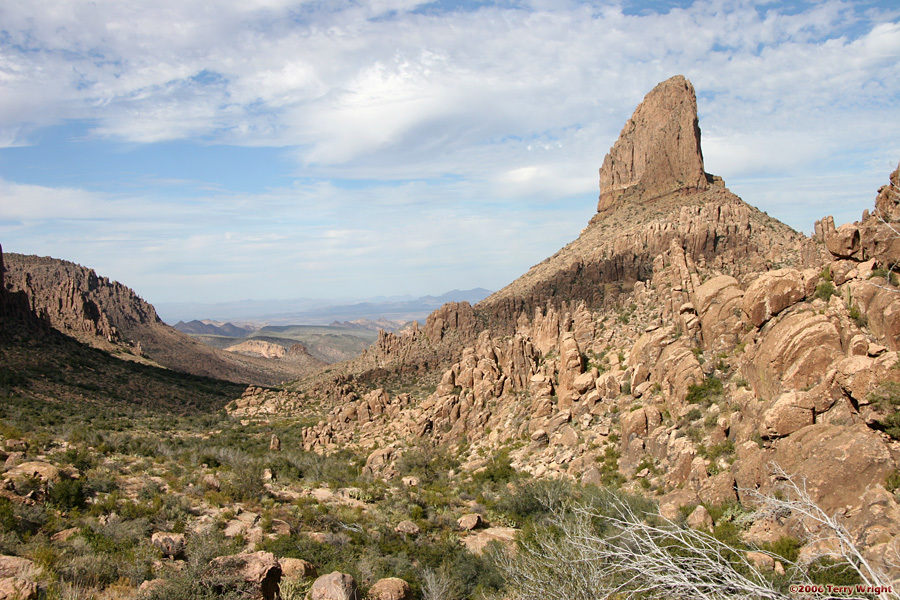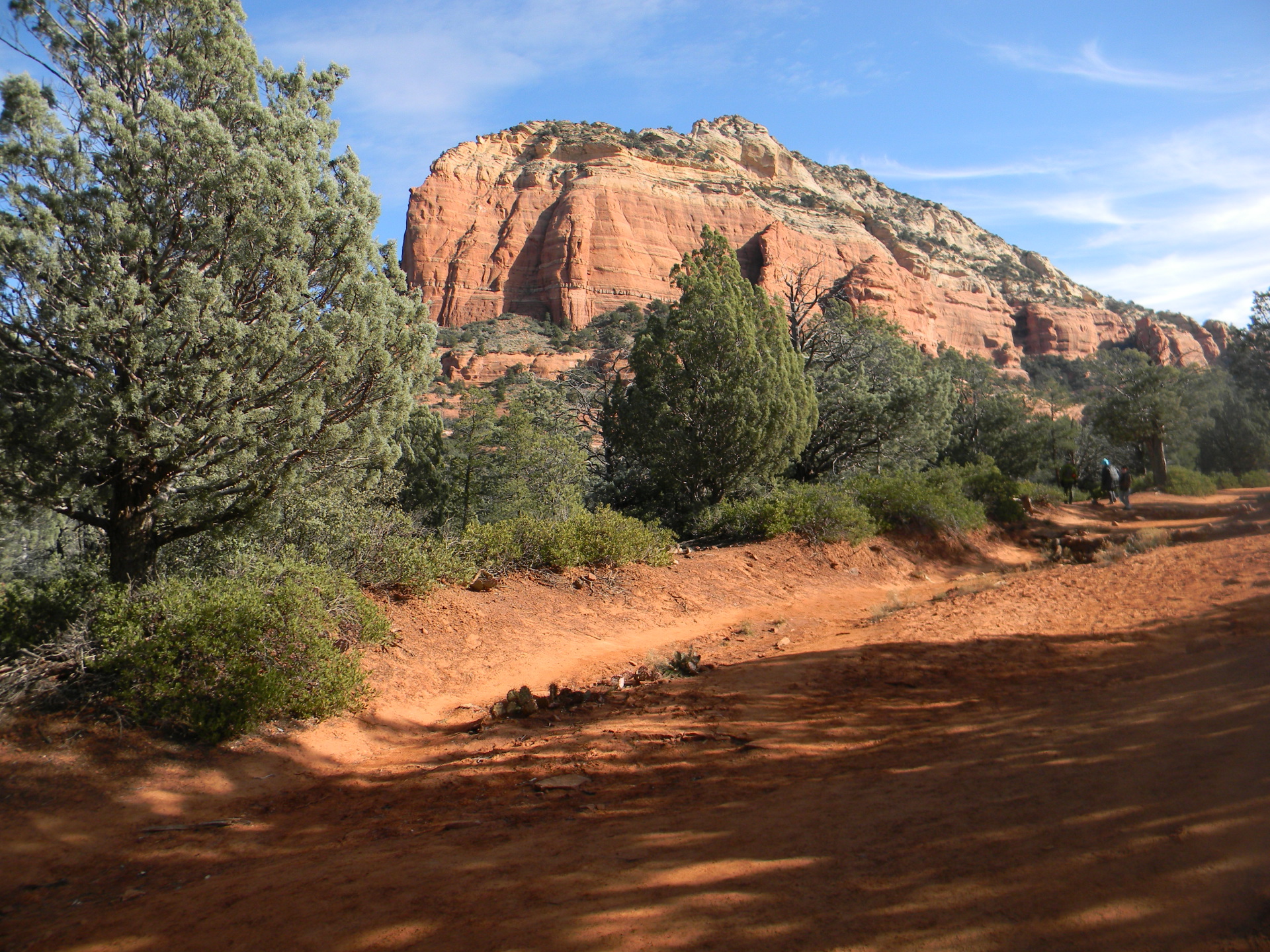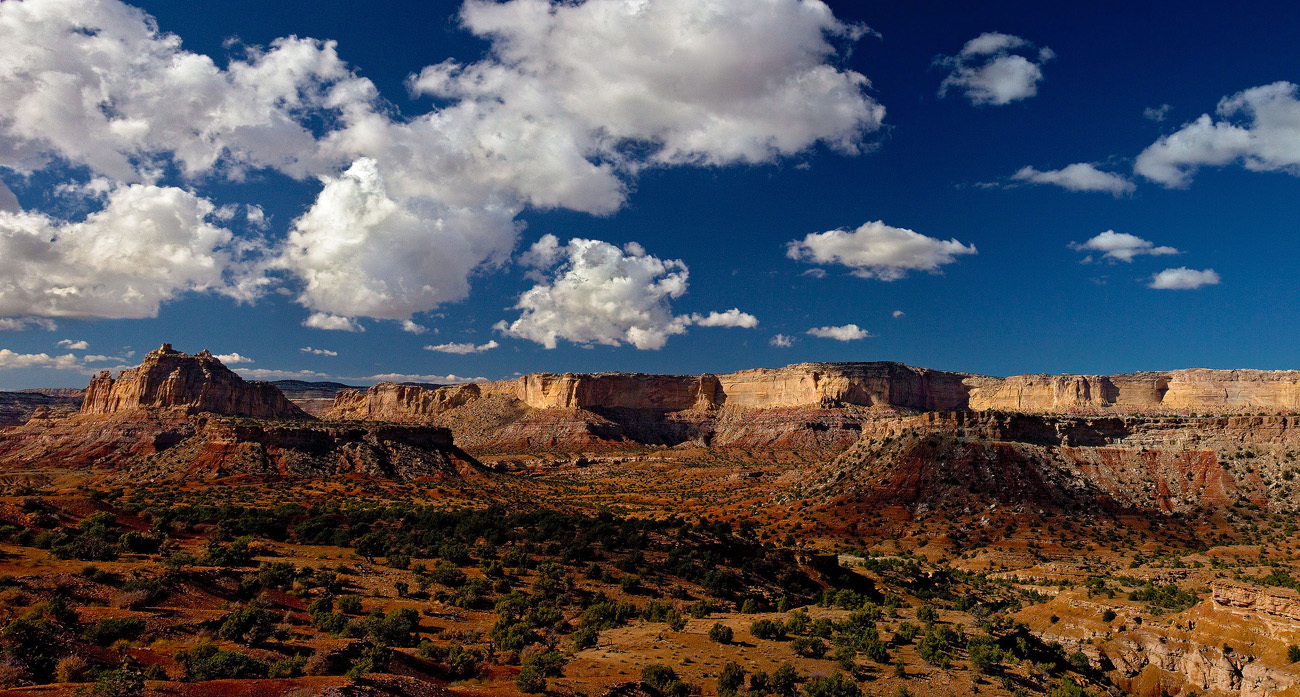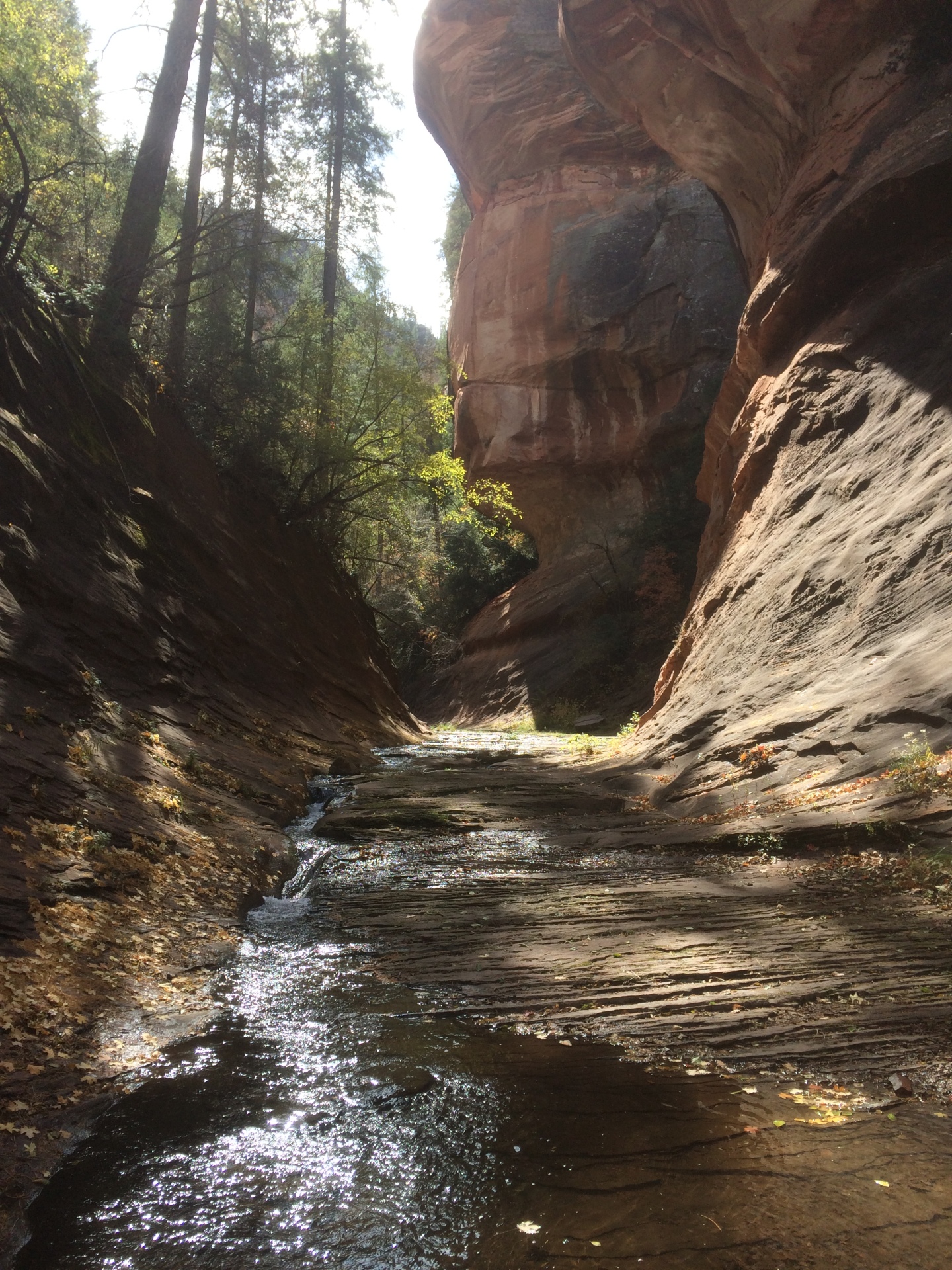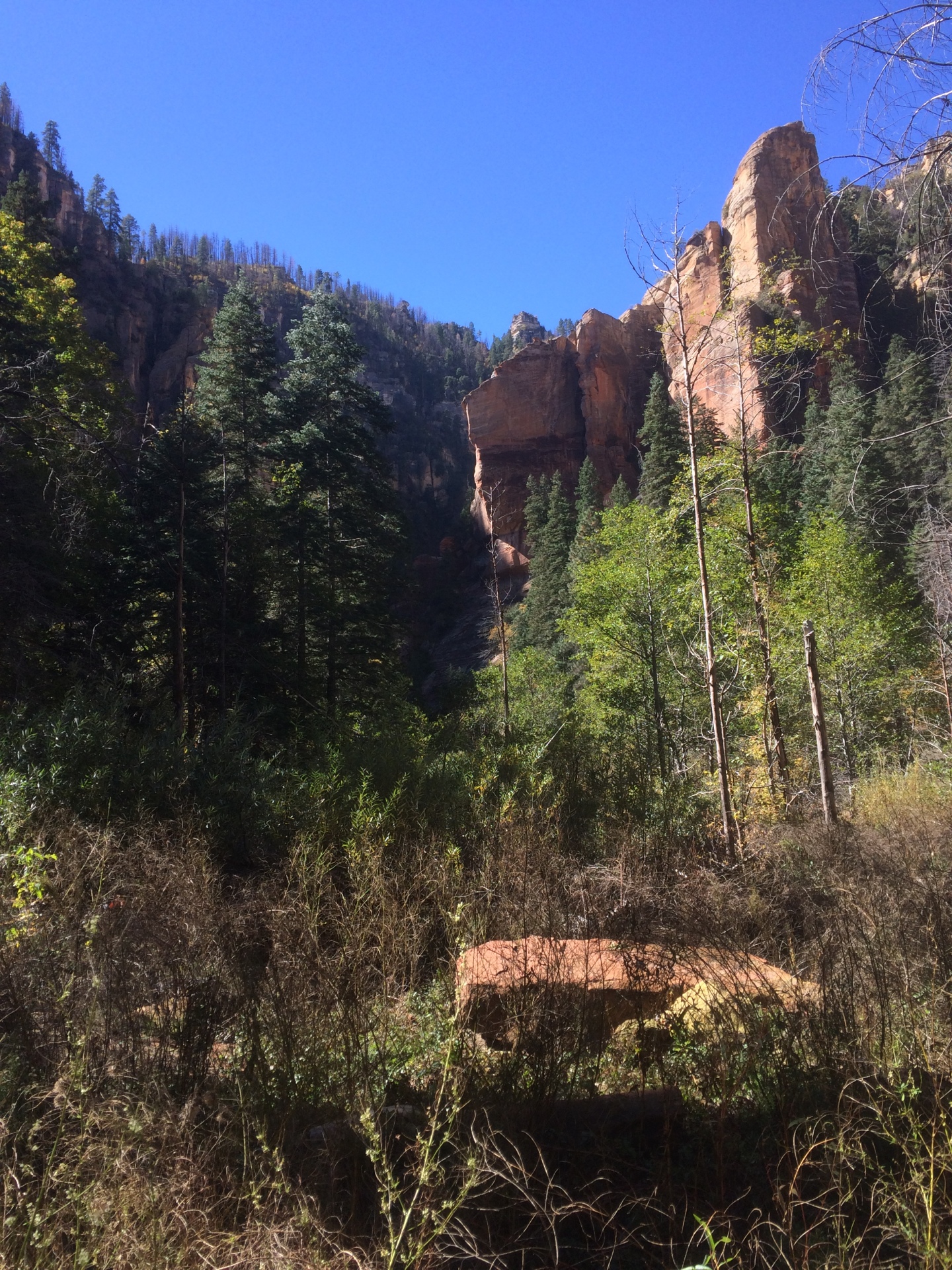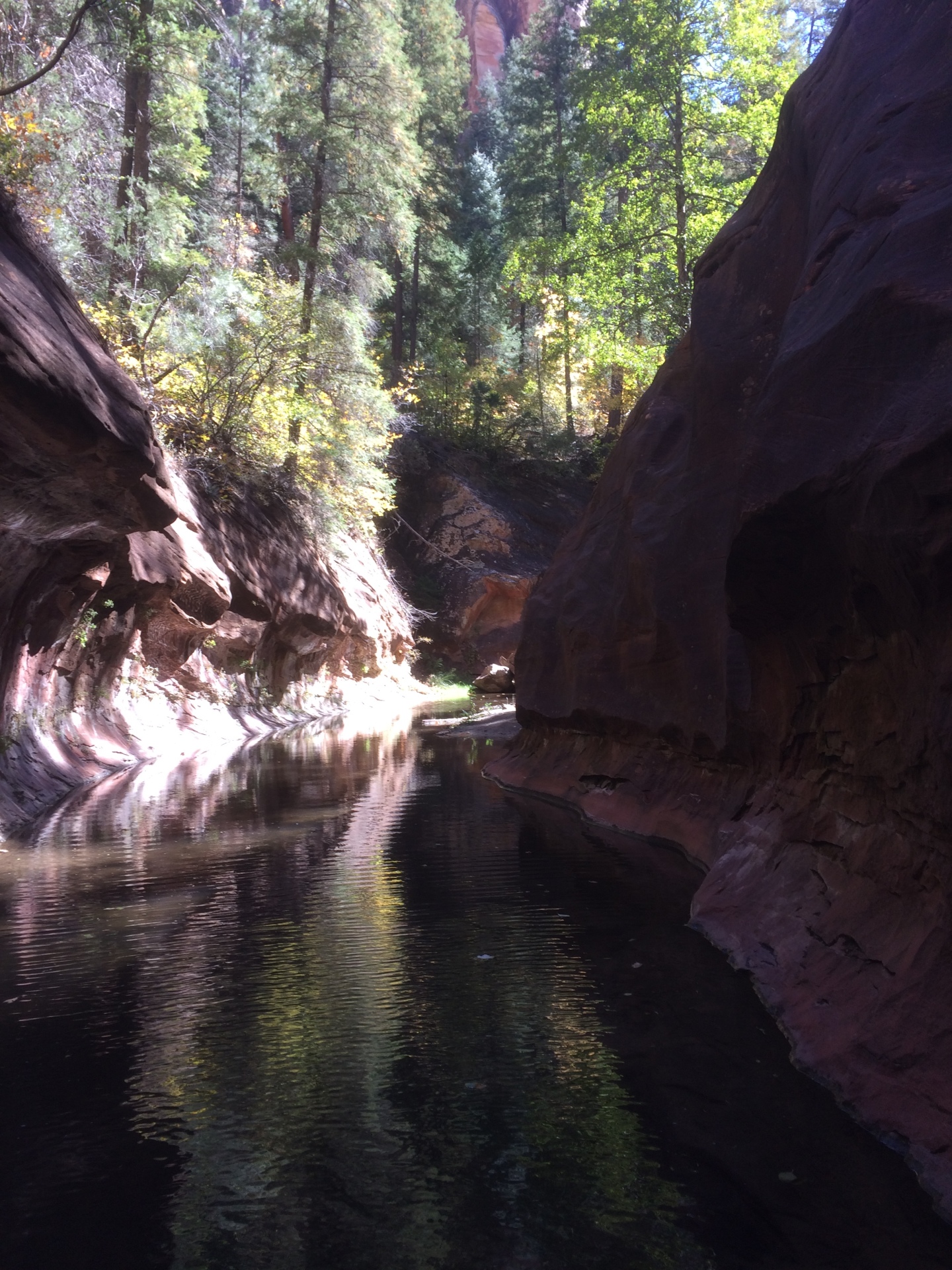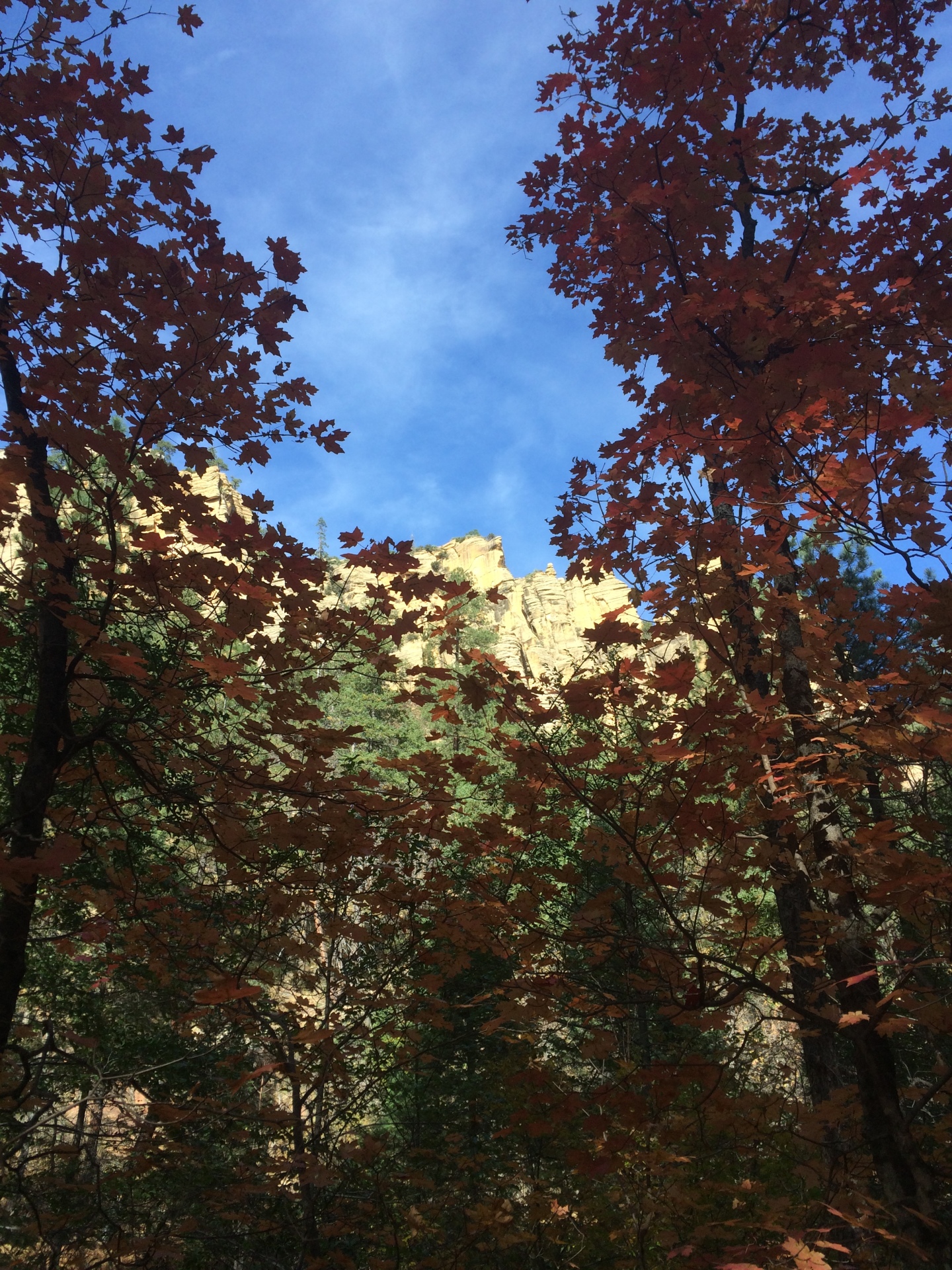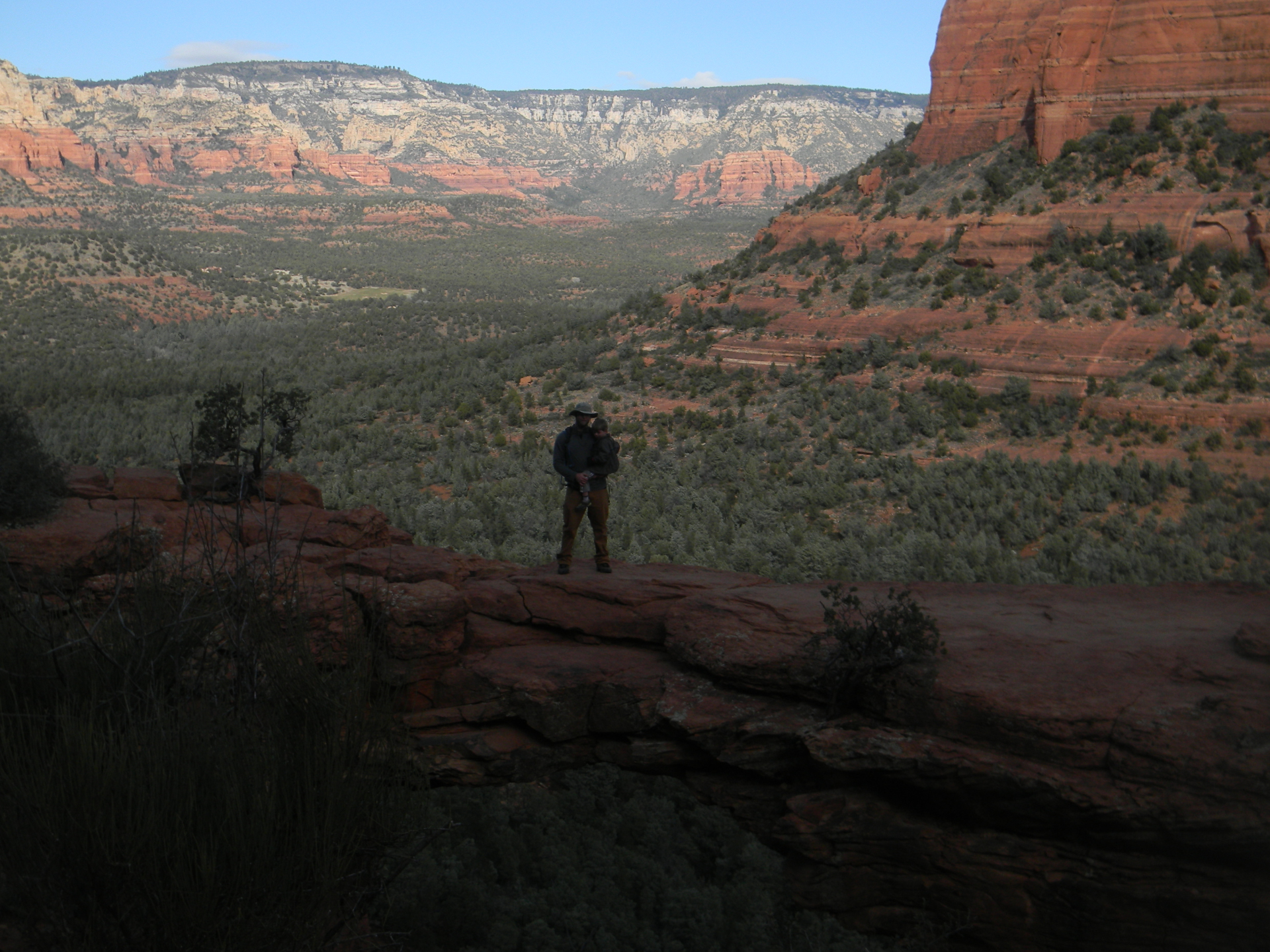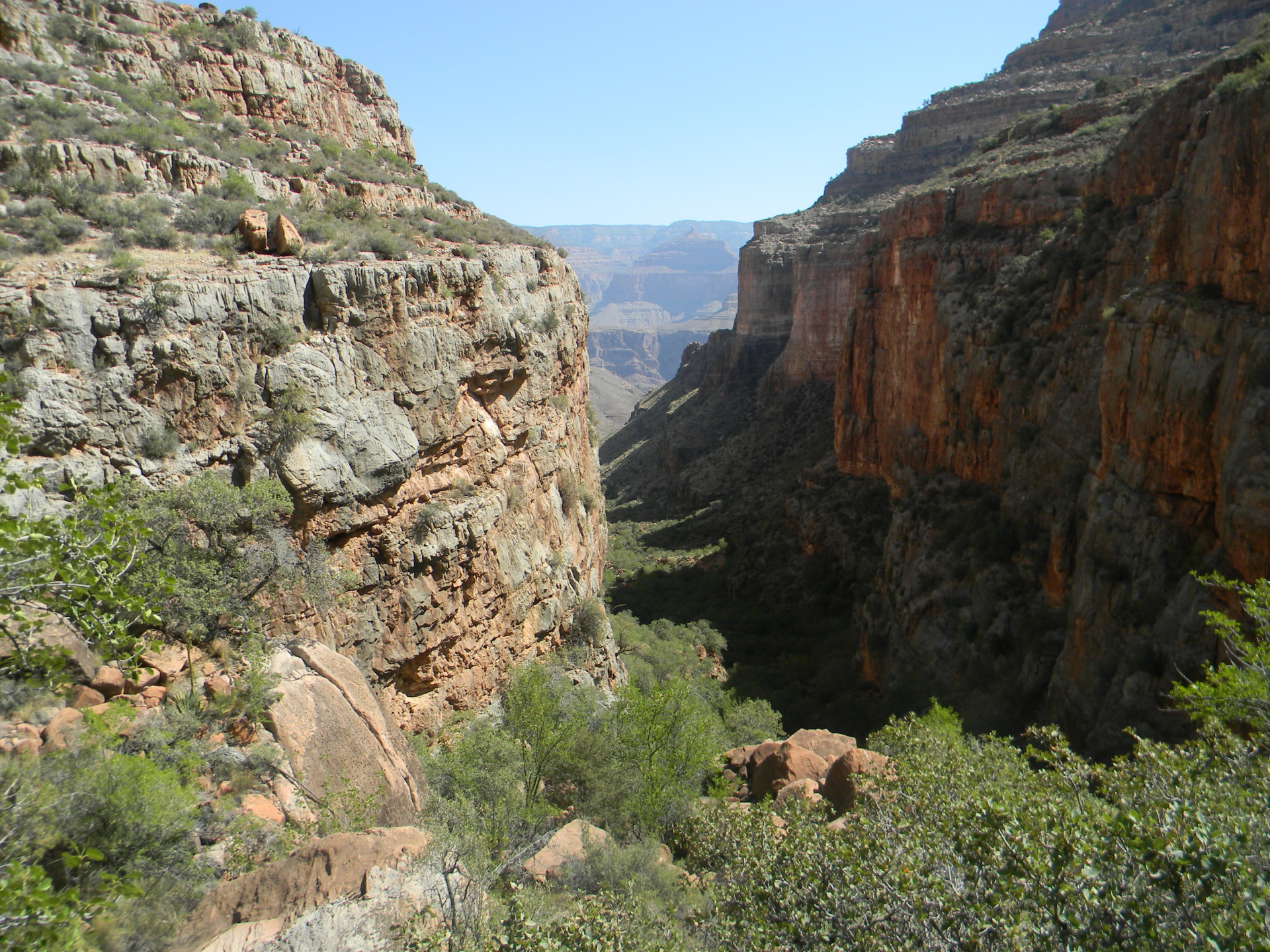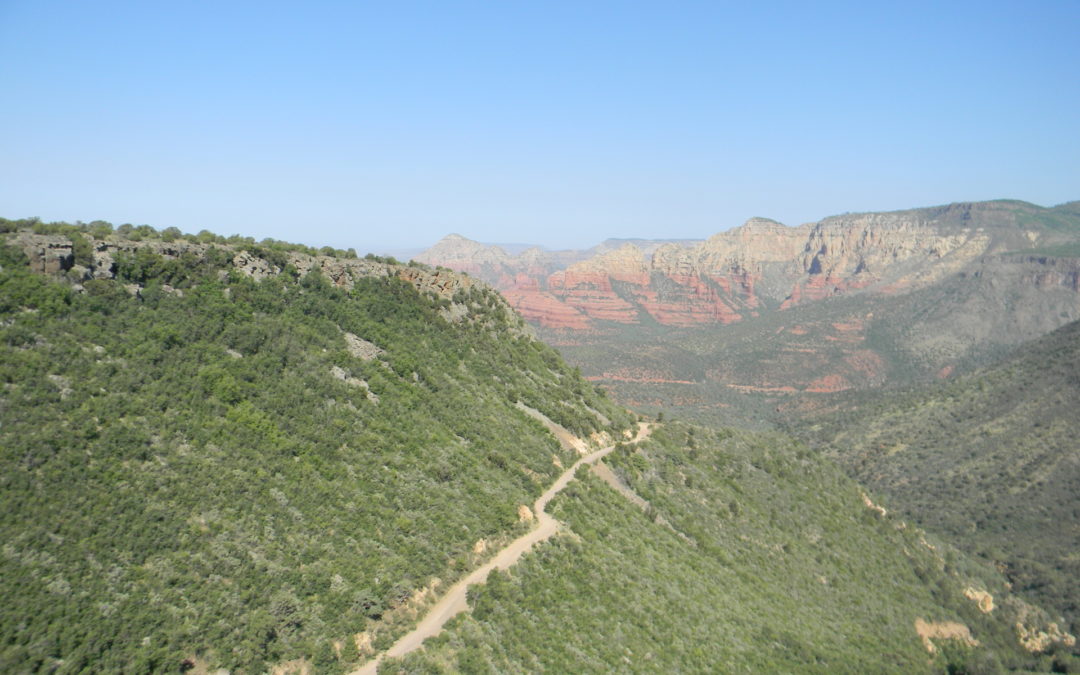
by The Goat | Aug 27, 2019 | Hiking, Sedona
Top 5 Hikes in Sedona
Sedona: The very mention conjures up blazing red rock sunsets, towering spires, monolithic cathedrals, and inspiring zen. Another phrase the word Sedona should conjure in your mind is this: world-class hiking. Sedona’s hundreds of miles of wilderness trails presents some of the most excellent hiking in the American Southwest, with sweeping iconic red rock vistas, wildlife, and, if you know where to look, relaxing and fulfilling solitude. Sedona’s hiking trails are also, of course, an excellent place to view the ebb and flow of ancient seas along the Pangean coastline many millions of years ago, making it of very special interest to Blue Marble’s Goat. Here, we have prepared for your hiking pleasure The Goat’s Top 5 Sedona Hiking Adventures. See you on the trail!
5. Bear Mountain, Red Rock-Secret Canyon Wilderness, Sedona
Bear Mountain, one of Sedona’s highest peaks at 6506 ft above sea level, is also one of Sedona’s most spectacular hikes. In addition, given that it is one of the more challenging and rugged trails, it is one of the least populated, as people opt for Red Rock Country’s easier trails. This is excellent news for you, because the reward for hiking the Bear Mountain Trail are some of the most spectacular views Sedona has to offer, which we don’t have to tell you means something. This is also a perfect hike in the cooler months, as the southern aspect and lack of shade maintains warm temperatures in the fall, winter, and spring. From the summit of this red rock monolith, all ten of Sedona’s stratigraphic layers can be seen and counted, making it of special importance to The Goat.
4. Secret Canyon, Red Rock-Secret Canyon Wilderness, Sedona
Secret Canyon is perhaps the quintessential Sedona hiking adventure. This popular trail into its namesake Red Rock-Scret Canyon Wilderness contains some of the most natural beauty of any hike in Sedona, with a cool stream, shade, excellent wildlife-viewing opportunities, fabulous rock formations, and an intimate Sedona canyon experience. What is most special about Secret Canyon, however, is that it is nearly as long, and perhaps even more beautiful than its more famous and populated neighbor Oak Creek Canyon. In any case, Secret Canyon is a tremendous hiking adventure in Sedona, and a wonderful introduction to Red Rock Country.
3. Wilson Mountain, Red Rock-Secret Mountain Wilderness, Sedona
The highest peak in Sedona at over 7100 feet above sea level, Wilson Mountains reigns supreme for sweeping views of Sedona and beyond. Excellent for hikers that are looking for more of a challenge, Wilson Mountain offers a rugged and adventurous trail that is a fabulous hike in the cooler months of the year. At the summit, the hiker is treated to dramatic views of Sedona Red Rock Country, Oak Creek Canyon, the Mogollon Rim, and on a clear day, all the way to the San Francisco Peaks north of Flagstaff.
2. Boynton Canyon, Red Rock-Secret Mountain Wilderness, Sedona
Boynton Canyon offers up one of the most spectacular canyon hiking experiences in the southwest, with towering red rock spires, buttes, mesas, and even a chance at wonderful solitude. Rock climbers particularly are interested in this beautiful trail, as many of the rock formations here lend an opportunity for some epic routes up the soaring red rocks. For the hiker however, Boynton Canyon is a special place in Sedona, as it is far enough removed from the town and its tourist traps that include the most popular trails, yet close enough to be reached in not much more time than it takes to reach some of the more popular destinations. Goat approved!
1. Loy Canyon, Red Rock-Secret Canyon Wilderness, Sedona
Loy Canyon earns our #1 ranking for one simple reason: diversity. Loy Canyon provides a unique Sedona canyon hiking experience that is unmatched in our humble opinion, with solitude, shade, expansive views down the canyon, and opportunities for excellent overnight trips and trail connecting. After a climb to the base of Secret Mountain, views into Loy Canyon are wide and dramatic, particularly in the morning and evening as soft light bathes the fiery red rocks and creamy sandstones that make Sedona famous. Don’t miss this one!
So there we have it, The Goat’s Top 5 Sedona Day Hikes. You can tackle these wonderful trails yourself, or enhance your experience with one of our fabulous geologist/guides who will let you in on all of Sedona’s secrets. See you on the trail!
Going Guided
Hiking and exploring Sedona is a special experience. Although it is possible to see these places yourself, hiring a guide is a great idea. For instance, guiding services provide logistical support, and plan everything for your best possible trip. They provide a great safety net on the trail, and are trained in backcountry medicine. Above all, they provide a depth of knowledge of the region that turns a walk into a true adventure.
Blue Marble Adventure GeoTourism provides all of the support you need, and pairs that with expert geologist/guides. Our backcountry meals use fresh ingredients, and are planned by a professional chef. Furthermore, we provide top-of-the-line gear and passion for the places we explore. In conclusion, you can visit National Parks, but going with a guide can create and even more memorable experience. Don’t be shy, and call us!
Read our blog!
For adventure hiking vacations in a geologic time machine, see our epic tours in Grand Canyon, Utah, and Arizona!
For geological musings read The Goat’s geology blog.
Follow us on Facebookand Instagram
Explore Further, Be Wild, See Through Time — Blue Marble Adventure GeoTourism

by The Goat | Aug 27, 2019 | Hiking, Sedona
Everything you need to know for Hiking in Sedona
Every year, thousands of people flock to the iconic red rock formations of Sedona, Arizona. They come from all over the state, all over the country, and all over the world to view and embrace the world famous vistas, world-class hiking, and spiritual zen that makes Sedona so famous. The views here are spectacular, the hiking, mountain biking, rock climbing, and outdoor adventure limitless, the geology almost confrontational, and the scale grand. But what should you, the savvy adventure traveler, know before you come to this iconic destination? The Goat is here to help you have the best time possible in this epic red rock getaway, including the best trails, the secret spots, and of course, how to make it back in one piece.
Location:
Sedona is located in the Arizona Transition Zone, about 1.5 hours north of Phoenix in Central Arizona.
Sedona can be approached from any direction, but the most scenic routes are from the north or the east. From the north, take Route 89A south from Flagstaff and wind your way through world famous Oak Creek Canyon. This drive is particularly spectacular in the fall, when the aspens, oaks, and willow trees are in full color. Approaching from the east on AZ SR 179 gives you an immediate and full introduction to Sedona’s famous red rocks, as you will see several of the most famous rock formations including Cathedral Rock, Courthouse Butte, and the Mogollon Rim. Take I-17 north from Phoenix and head west on SR 179.
Local’s Secret: Approaching via Schnebly Hill Road is truly the way to go, provided you have a capable (preferably high-clearance 4×4) vehicle. From Interstate 17, take the Schnebly Hill Road exit, and enjoy the backside approach and spectacular views.
Seasons:
Sedona is classified as high desert, with mild winters, hot summers punctuated by rainstorm events known as monsoons, and arid climate vegetation such as cactus, piñon pine trees, manzanita, ocotillo, and yellow marigold. The premier seasons to hike here are September-June, as summer temperatures on the trail can routinely exceed 100 degrees in the middle of the day.
Local’s Secret: Sedona, and its neighbor Oak Creek Canyon, have hikes for all seasons. Oak Creek, in particular, stays cool and shady when it’s too hot to hike in Sedona. Check out West Fork of Oak Creek Canyon Trail, it’s one of the best in the country!
Terrain:
Sedona and Oak Creek Canyon have highly variable terrain, ranging from flat and easy canyon hikes to strenuous mountain climbs and just about everything in between. The soil here is quite rocky, as are most of the trails, so most hikes in Sedona or Oak Creek will require at least some sturdy athletic shoes. In many cases, trails in Oak Creek cross the water, so be aware of the trail you are about to embark and bring the proper footwear.
Summer Activities:
Here is a small sampling of the great activities to engage in while visiting Sedona in the warm months (May-September)
- Hiking – Be sure to get an early morning, or evening start to avoid mid-summer temps
- Mountain Biking – Sedona has world-class sandstone mountain biking trails
- Rock Climbing – Oak Creek Canyon has some of the best technical routes in the state
- Camping – Check out the Forest Service for group sites
- Horseback Riding – Saddle up!
- 4×4 Tours – There are many excellent and adventurous Jeep trails in the surrounding area
- Helicopter Tours – Should the mood strike you, a Red Rock Heli Tour may just hit the spot
- Wining, dining, and exploring the towns of Oak Creek and Sedona
- Kayaking – The Verde River offers some of the most scenic and relaxing paddling in the southwest
Fall/Winter/Spring Activities
When temperatures cool off, there is even more to do in Sedona and Oak Creek!
- Hiking – If there is no snow, winter hiking in Sedona is a must!
- Rock Climbing – Cooler temps open many of the classic routes in Sedona’s red rock country
- Mountain Biking – the wet and cooler temperatures make winter mountain biking a blast in Sedona
- Yoga Retreats
- Wining, Dining, and exploring the towns of Oak Creek and Sedona
For more information about hiking and adventuring in Sedona and Oak Creek, give us a call! Our geologist/guides will be happy to show you around, and point you in the right direction!
Want to know more about our Guided Sedona Hiking Tours?
Going Guided
Hiking and exploring Sedona is a special experience. Although it is possible to see these places yourself, hiring a guide is a great idea. For instance, guiding services provide logistical support, and plan everything for your best possible trip. They provide a great safety net on the trail, and are trained in backcountry medicine. Above all, they provide a depth of knowledge of the region that turns a walk into a true adventure.
Blue Marble Adventure GeoTourism provides all of the support you need, and pairs that with expert geologist/guides. Our backcountry meals use fresh ingredients, and are planned by a professional chef. Furthermore, we provide top-of-the-line gear and passion for the places we explore. In conclusion, you can visit National Parks, but going with a guide can create and even more memorable experience. Don’t be shy, and call us!
Read our blog!
For adventure hiking vacations in a geologic time machine, see our epic tours in Grand Canyon, Utah, and Arizona!
For geological musings read The Goat’s geology blog.
Follow us on Facebookand Instagram
Explore Further, Be Wild, See Through Time — Blue Marble Adventure GeoTourism
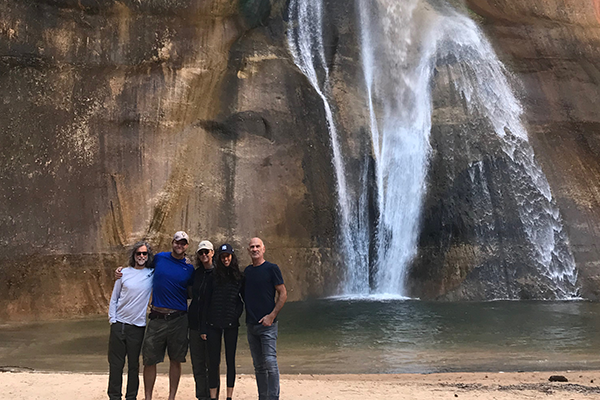
by The Goat | Aug 27, 2019 | Backpacking, Grand Canyon, Grand Staircase-Escalante, Hiking, Sedona, Utah Canyon Country
Top 5 Basecamping Trips in the Southwest
Basecamping can provide a truly wonderful experience that explores the best of both worlds in the outdoors: excellent hiking adventures by day, and comfortable accommodations by night. Hiking in the southwestern United States provides the adventurer with endless opportunities to see outrageous and iconic scenery, experience world-famous geology, and enjoy the whimsical color tapestry that pulls at the senses. The Goat has decided to let you in on his personal favorite hiking and camping adventures in the American Southwest, so load the car, strap in, and grab the camera ’cause we’re going outside!
5. Death Valley National Park and Mojave National Preserve, California
Though just the name evokes a barren wasteland of intense heat and suffering, long-time westerners know that Death Valley is one of the most fabulous places on the face of the Earth. It is a land of extremes, but one of those extremes is intense beauty. Being in Death Valley confronts the hiker with the dichotomy of life itself, in one breath being the lowest, hottest place in North America, in the other breath being a place with 11,000 foot mountains that receive feet of snow every winter.
In one breath being a howling desert, in the other being a place with flowing natural springs and over 1,000 different species of animal, including several like the Devil’s Hole Pupfish, that are indigenous to Death Valley and only Death Valley. To the east of Death Valley lies the Mojave National Preserve, a little-known slice of desert heaven that holds its own distinctions.
Think the largest, densest stand of Joshua Tree, icon of the Mojave, lies in Joshua Tree National Park? Think again. That belongs to Mojave National Preserve. Think the tallest sand dune in the United States lies in Great Sand Dunes National Park? Think again. Kelso Dune, which rises nearly 900 feet above the desert floor reigns supreme, right in the heart of the Mojave National Preserve. Death Valley and the Mojave National Preserve is a southwestern adventure that is not to be underestimated in its grandeur, taken for granted in its diversity, or passed up by the outdoor adventurer.
4. North Rim, Grand Canyon National Park, Arizona
The visitation to Grand Canyon is well-documented. Last year alone (2015) Grand Canyon National Park received over 6 million visitors for the first time in its history, breaking the string of a decade at over 5 million. To say it is well-loved is a bit of an understatement, and for good reason; It’s the Grand Canyon. However, over 90% of people that visit Grand Canyon visit the easily accessible South Rim, and only 5% of total people that visit actually go below the rim, given that the average visit time to this fabulous natural wonder is about 2.5 hours.
This leaves us with the isolated, lonely North Rim. Grand Canyon’s North Rim, which soars to over 8,500 feet on the Coconino Plateau, sees about 1/10 of the visitors that flock to the South Rim; good news for you. From the North Rim, hikers and campers are treated to all the dramatic vistas, epic geology, and fantasy of the Grand Canyon, but with a sense of solitude that can be hard to bargain for at the South Rim. North Rim contains some of the park’s most thrilling hiking adventures, outrageous fall colors, and even brings a sense of the pioneer spirit to any of its adventures.
3. Superstition Mountains, Arizona Sonoran Desert
Some say it’s the views. Some say it’s the ancient spirits. Some say it’s the lost gold mine. The Goat says he’s just lucky. The Superstition Mountains, located just 45 minutes east of the heart of Phoenix, Arizona, provide some of the best hiking, backpacking, and camping opportunities near a large metropolitan area in the United States, and perhaps the world. Hiking and exploring this fantastic wilderness from a basecamp, however, may just be the best way to see it.
Legend has it that within the Superstition Mountains lies an incredibly rich gold mine, the likes of which Arizona has never seen. The Dutchman, Mr. Jakob Waltz (who was actually German) gave clues on his deathbed as to its whereabouts, but it has yet to be located. Camping near the wilderness and tackling its hundreds of miles of excellent trails gives the outdoor adventurer a wonderful opportunity to search high and low, through deep canyons to 5,000 foot peaks. Meanwhile, sweeping views, excellent and explosive geology, and in the heart of the wilderness, solitude await as you dive deep into the legends and lore of the fabulous Superstition Wilderness.
2. Sedona, Arizona Red Rock Country
Sedona is world famous for its grand red rock monoliths, spiritual healing power, and upscale tourist traps. However, we geologists think of Sedona as the “Pangean Riviera”, as the beautiful rocks here tell a wonderful story of a paradise by the sea.
Though it’s lost its ocean views over the eons, Sedona is still one of the most gorgeous places in the American Southwest, and a base camping trip here will give the intrepid hiker and explorer all they can handle, from rugged red rock cliffs and world-class rock climbing, to intimate canyons, to soaring spires and outrageous sunsets whose colors can only be matched any the rocks themselves!
1. Capitol Reef National Park and Grand Staircase-Escalante National Monument, Utah Canyon Country
This tour de force of South Central Utah’s two epic parks will forever change your vision of what Utah’s Canyon Country is truly all about. Think you’ve seen it all? We think you’ve seen almost nothing until you behold the majesty contained within Capitol Reef and the Grand Staircase. Capitol Reef, home to the largest geologic structure in the southwest, harbors towering sunset red cliffs, arches, canyons, and utter solitude, with some of the best star-gazing in the lower 48. Grand Staircase is home to some of the most rugged, thrilling, and scenic canyons and slots on the Colorado Plateau and the entire world.
Placing your basecamp near the town of Boulder, Utah will lend you, the intrepid hiking adventurer, an opportunity to ping-pong between these two giants. The close proximity, beauty, and above all the unspoiled wilderness experience you are highly likely to obtain in these two outstanding places was the deciding factor in our countdown. The Goat approves!
So there you have it ladies and gentleman, the Top 5 Camping and Hiking Trips in the American Southwest. You can tackle them yourself, or to enhance your experience, you may choose to tackle them with our fabulous geologist/guides that will school you on every whit and whimsy in these beautiful rocks. See you on the trail!
Going Guided
Hiking and exploring Grand Canyon, or any of the National Parks, is a special experience. Although it is possible to see these places yourself, hiring a guide is a great idea. For instance, guiding services provide logistical support, and plan everything for your best possible trip. They provide a great safety net on the trail, and are trained in backcountry medicine. Above all, they provide a depth of knowledge of the region that turns a walk into a true adventure.
Blue Marble Adventure GeoTourism provides all of the support you need, and pairs that with expert geologist/guides. Our backcountry meals use fresh ingredients, and are planned by a professional chef. Furthermore, we provide top-of-the-line gear and passion for the places we explore. In conclusion, you can visit National Parks, but going with a guide can create and even more memorable experience. Don’t be shy, and call us!
Read our blog!
For adventure hiking vacations in a geologic time machine, see our epic tours in Grand Canyon, Utah, and Arizona!
For geological musings read The Goat’s geology blog.
Follow us on Facebookand Instagram
Explore Further, Be Wild, See Through Time — Blue Marble Adventure GeoTourism

by The Goat | Aug 27, 2019 | Geology, Hiking, Sedona
What Makes Sedona so Special?
Every year, millions of tourists from all over the world flock to Sedona, AZ to see scenes published in magazines the globe over. They marvel at the fantastical red rocks, find zen in the spiritual vortex’s, and bask in the warm glow of one of the southwest’s premier geological wonders. But how did it get this way? The Goat knows.
West Fork Canyon, Oak Creek near Sedona, AZ
Our story begins nearly 320 million years ago in the Mississippian epoch of the Paleozoic era. Near the southwestern edge of the supercontinent known as Pangea, there is a white sand beach on a coastline with fertile rivers, tropical sunshine, and dense vegetation. Large, predatory fish scour out in the sea, while small reptiles and amphibians cruise the lush coast in search of food and shade.
The air is moist and warm here near the equator, and life is simple. Over the next 10 million years, the sea slowly regresses and the rivers flow out, carrying sediment eroded from the Ancestral Rocky Mountains across floodplains in a large, lazy meander. From Sedona to the Grand Canyon, the uppermost members of the Supai Group, known today as the Esplanade Sandstone, the Hermit Shale, and the Schebly Hill Formation are deposited in this proximal-marine, balmy, beachy, environment. This oxidized sediment gives the foundation for the blazing reds, oranges, and greens of modern-day Sedona as they are buried and turned to stone.
One of our clients strolling through blazing Sedona fall colors
As the seas recede and the rivers dry out with a drying climate, a massive sea of sand dunes migrates over the continent in a parched, desolate, desert landscape. Small reptiles scuttle across the dunes, drinking the water trapped under them in monsoonal rain events. This arid, windy dune sea, reminiscent of the modern-day Sahara, covers an area from south of Sedona to modern-day Montana, covering nearly 1/3 of the North American continent roughly 290 million years ago in the upper Permian epoch. These blonde dunes lay the foundation for the towering cliffs seen north of Sedona in Oak Creek Canyon, known today as the Coconino Sandstone.
Towering spires and cliffs in the Coconino Sandstone
Near the end of the Permian, nearly 273 million years ago, a warm shallow sea overtakes the sand dunes. This sea is teeming with life in an extensive coral reef system that is home to brachiopods, ammonites, bryozoans, sponges, and other non-vertebrate marine life, as well as small vertebrate fish. As these animals die, their carbonate shells mix with sediment to form a calcium-carbonate rock, known as limestone.
This limestone will be known as the Kaibab Limestone, and it forms the rims of both Oak Creek Canyon and the Grand Canyon further to the north in Arizona. This hard, erosion-resistant limestone protects the softer, more fragile formations under it, which will be very important over the next 270 million years.
Sparkling Pools in a hidden Canyon, Sedona, AZ
The Kaibab Limestone is the final sedimentary layer deposited in the Sedona region near the southwestern edge of Pangea, but it is far from the final geologic process that formed this wondrous place. The end of the Permian transforms life on Earth, as a mass extinction inflicts a 95% mortality rate of all species on Earth.
In the early Triassic of the Mesozoic, the age of the large reptiles, massive jungle swamps covered the land, forming the Chinle group and the Painted Desert. Still more cycles of rivers and floodplains ensued through the Jurassic into the Cretaceous as volcanoes formed and erupted, and Pangea broke apart, giving rise to the current continental map.
Sun-bathed Coconino Sandstone cliffs near Oak Creek
The Rocky Mountains were built in the north by the Laramide Orogeny, a process responsible for not only the mountains themselves, but some of the wonderful faults and structures such as anticlines and synclines that can be found in Sedona and around the region. During this process, something very important happened, as the plate sliding under the North American plate, known as the Farallon plate, suddenly snapped off about 25 million years ago, a portion of it remaining just below the crust in the mantle.
How was the Colorado Plateau formed?
This caused an entire region to be uplifted as the bouyant piece of plate quite literally “floated” in the mantle. This region, known now as the Colorado Plateau, was bounded by volcanic mountains as magma near the margins of the Farallon plate began to issue through weaknesses in the crust caused by the floating plate.
The Goat stands on famous Devil’s Arch in the Red Rock-Secret Mountain Wilderness of Sedona
Sedona itself lay at the very southwestern edge of this action, very near to several volcanoes and an ancient mountain range known as the Mogollon Highlands to its south. It was then that the North American plate began to “slide” back out over the Farallon and Pacific plates. This action formed the Basin and Range that encompasses Phoenix, Tucson, Las Vegas, and Death Valley today as areas of massive faulting, volcanism, and large, sediment-collecting basins.
Sedona was quite literally caught in the middle of this action. As the Mogollon Highlands “slid” to the south and the rivers that once flowed north from them ceased, new rivers began to cut south into the receding lowlands as the crust rifted. Faults, such as the Oak Creek and Verde faults, became active, cutting canyons (Oak Creek, Walnut Canyon, Sycamore Canyon) to the north and accommodating more river flow into the newly-formed valleys and basins left open by the receding Highlands.
Volcanoes continued to erupt to the north and south, issuing lava flows and ash that now dot the landscape. The basalt that caps Oak Creek Canyon is just under 8 million years old, and preserved the soft sediments beneath it as the newly created Oak Creek and its mother fault cut the canyon.
A hidden canyon near Sedona
These rivers chiseled out courses in the buttery sediment, leaving behind the fantasy-lands we see today. Many of these rivers still course their way down the valleys today, their work never done. Iconic and wondrous formations such as Cathedral Rock, The Coffee Pot, Wilson Moutain, and Vultee Arch are all remnants of these combined processes of sediment deposition, burial, mountain-building, volcanic eruptions, and water-based erosion. Come with us as we explore them all!
Going Guided
Hiking and exploring Sedona is a special experience. Although it is possible to see these places yourself, hiring a guide is a great idea. For instance, guiding services provide logistical support, and plan everything for your best possible trip. They provide a great safety net on the trail, and are trained in backcountry medicine. Above all, they provide a depth of knowledge of the region that turns a walk into a true adventure.
Blue Marble Adventure GeoTourism provides all of the support you need, and pairs that with expert geologist/guides. Our backcountry meals use fresh ingredients, and are planned by a professional chef. Furthermore, we provide top-of-the-line gear and passion for the places we explore. In conclusion, you can visit National Parks, but going with a guide can create and even more memorable experience. Don’t be shy, and call us!
Read our blog!
For adventure hiking vacations in a geologic time machine, see our epic tours in Grand Canyon, Utah, and Arizona!
For geological musings read The Goat’s geology blog.
Follow us on Facebookand Instagram
Explore Further, Be Wild, See Through Time — Blue Marble Adventure GeoTourism


